Are businesses fully equipped to navigate the complexities of the die cutting machine market? With an overwhelming array of options, understanding which machine best aligns with a company’s needs can prove to be a significant difficulty.
Addressing this challenge, we made a thorough comparison, and we’ve found a few standouts die cutting machines worthy of special attention. This guide offers a comprehensive insight into die cutting machines. It delves into topics such as the basics of die cutting machine, detailed comparisons of popular die cutting machine models, criteria for comparing die cutting machines, features, and making the right choice.
The aim is to equip businesses with the knowledge to make informed decision, maximizing productivity and value. For an enlightening exploration of die cutting machines, read on.
1. The Basics of Die Cutting Machine
When delving into the realm of crafting or manufacturing, one essential piece of equipment to comprehend is the die cutting machine. A die cutting machine, essential in many industries, precisely cuts materials into specific shapes. Its main components include the die, cutting pad, and machine roller. The die dictates the design, the cutting pad shields against damage, and the machine roller applies pressure for the cut.
Diverse operational mechanisms define die cutting machine types. In my experience, manual machines rely on hand-levers, ideal for simple tasks and portability. Conversely, digital versions use software, offering intricate designs and efficiency, best suited for larger production demands.
2. Detailed Comparisons of Popular Die Cutting Machine Models
Choosing the right die cutting machine can feel like a daunting task with a sea of options available in the market. To ease this process, we’re bringing a detailed comparison of some popular models. This comparison will provide valuable insight to help the organization make an informed choice. Here are some key points to keep at the forefront:
Sizzix Big Shot Machine
Stepping into the limelight first is the Sizzix Big Shot Machine. This is a manual die cutting machine known for its robust construction and versatile cutting abilities. It’s an ideal machine for businesses that require a straightforward, reliable, and no-fuss cutting solution. This machine’s popularity comes from its ability to handle a wide range of materials, making it a valuable asset for many companies.
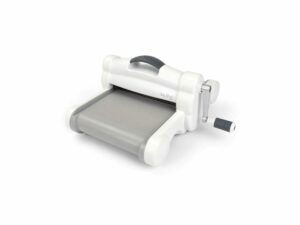
Features
- Wide Cutting Path: Accommodates materials up to 6 inches wide.
- Multi-Material Cutting: Capable of cutting everything from paper to fabric.
- Extended Multipurpose Platform: Allows the use of various die sizes.
- High-Quality Construction: Built to last with robust, durable components.
- Manual Operation: Hand crank system for controlled, repeatable cuts.
Pros
- It can work with a wide variety of dies and embossing folders.
- Made of high-quality materials to ensure longevity.
- Can handle many different types of materials.
- Straightforward to use and easy to maintain.
Cons
- Can only accommodate materials up to 6 inches wide.
- The hand crank system might be labor-intensive for large volumes.
- Additional costs for purchasing various dies.
Cricut Explore Air 2
Next on the list is the Cricut Explore Air 2, a digital die cutting machine that takes crafting and designing to a new level. With this model, businesses gain access to precision cutting and a host of user-friendly digital features. Ideal for operations that demand intricate designs and seamless production, the Cricut Explore Air 2 stands as a promising option.
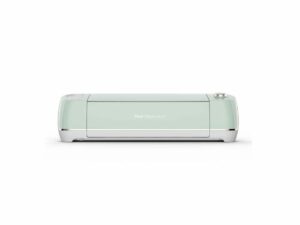
Features
- Dual-Tool Holder: Can cut and write or cut and score in one step.
- Fast Mode: Allows for up to 2x faster cutting and writing.
- Wireless Capability: Bluetooth technology for clutter-free workspace.
- Wide Material Compatibility: Works with over 100 different materials.
- Design Software: Comes with Cricut’s Design Space software.
Pros
- Offers the ability to cut, write, and score.
- Fast mode increases productivity.
- Bluetooth connectivity offers convenience and flexibility.
- Extensive Material Compatibility and can cut a wide array of materials.
Cons
- Requires time to get familiar with the software.
- Online dependency needs an internet connection to access full features.
- The maximum cutting width is 12 inches.
Brother ScanNCut DX
Moving on, the Brother ScanNCut DX is a highly advanced digital die cutting machine that is designed for precision and convenience. It brings to the table a unique combination of cutting-edge technology and user-friendly design. This machine is ideal for businesses looking to streamline their design and cutting process while maintaining high-quality output.
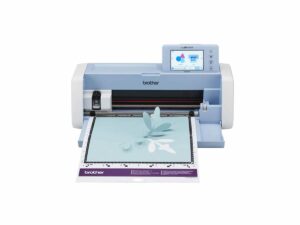
Features
- Auto Blade Sensor Technology: Detects the thickness of the material for precise cuts.
- Built-in Scanner: Can scan and create custom cut files.
- Large LCD Touchscreen: Easy operation and on-screen editing.
- Wireless Connectivity: Allows for the transfer of cut files without a cable.
- Extensive Design Library: Comes with 682 built-in designs.
Pros
- The auto blade sensor ensures accurate cuts every time.
- The built-in scanner allows for customized designs.
- The large LCD touchscreen simplifies the process.
- Easy transfer of files enhances productivity.
Cons
- More expensive compared to other models.
- Can only handle materials up to 3mm thick.
- Some users may find the proprietary software restrictive.
Silhouette Cameo 4
Here’s the Silhouette Cameo 4. This digital die cutting machine is a powerhouse of functionality and performance. It caters to businesses that require high-speed operation without compromising on precision. Its cutting-edge features make it a competitive choice for a range of industries.
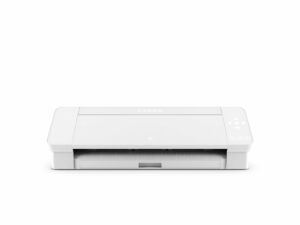
Features
- Increased Cutting Force: Boasts a cutting force of up to 5000g.
- Dual Carriage: Allows for simultaneous tool use.
- Smart Tool System: Automatically detects tools and adjusts settings.
- Matless Cutting: Ability to cut certain materials without a mat.
- Built-In Roll Feeder: Allows for easy loading of rolled materials.
Pros
- Ensures clean cuts even on dense materials.
- The dual carriage system speeds up the cutting process.
- The smart tool system ensures optimal settings.
- Offers matless cutting for certain materials.
Cons
- The advanced features may require some time to master.
- Users may experience a few hiccups with Silhouette Studio.
- Some users find the machine to be louder than others.
Sweet Box Making Machine
The Autoboxup Sweet Box Making Machine stands out as a prime example of engineering tailored for producing intricate and refined sweet boxes. Its inception has revolutionized the way businesses approach the creation of these delicate containers, blending innovation with functionality. As a vital tool in the realm of packaging, the machine’s design caters to both the aesthetic and practical requirements of modern businesses.
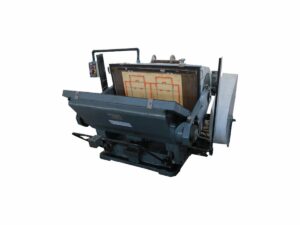
Features
- High-speed operation: Enables faster production rates, catering to high-demand scenarios.
- Advanced automation: Reduces manual intervention, streamlining the entire production process.
- Versatile design capabilities: Allows for the creation of various box shapes and sizes to cater to diverse requirements.
- Eco-friendly operation: Designed to minimize waste, promoting sustainable production practices.
- Integrated quality checks: Ensures every box produced meets set quality standards, reducing potential defects.
Pros
- Significant increase in production efficiency due to its high-speed capabilities.
- Reduction in labor costs attributed to its advanced automation features.
- Ability to cater to custom design needs, offering businesses flexibility in packaging designs.
- The eco-friendly aspect ensures minimal wastage, resonating with modern sustainable business practices.
Cons
- Initial setup and calibration can be time-consuming.
- Requires regular maintenance to ensure optimal performance.
- A larger footprint may require more factory or workshop space.
3. Criteria for Comparing Die Cutting Machines
Selecting a die cutting machine is more than just picking a brand or going for the one with the most appealing aesthetics. It involves a thorough evaluation based on several key criteria. In this section, we’ll dissect the elements that should inform the selection process. See the following details below:
Quality and Durability
Assessing a die cutting machine’s quality and durability is fundamental. For example, a machine’s sturdiness equates to superior performance and long-term use. Considering the quality of materials used in construction promises a return on investment. However, attention should also be paid to consumable components like cutting pads and blades; their longevity matters, affecting performance and ongoing costs.
This table is designed to highlight the various aspects related to the quality and durability of die cutting machines. The descriptions are based on the provided information and intended to provide a general understanding of these aspects. Actual specifications and metrics may vary based on specific machine models and manufacturers.
| Quality and Durability Aspects |
Description |
| Sturdiness and Construction |
The quality of a die cutting machine’s construction determines its sturdiness, leading to reliable, long-term performance. High-quality materials contribute to durability and extended machine life. |
| Performance and Reliability |
Sturdy die cutting machines offer consistent and reliable performance, ensuring accurate cutting results over time. This quality reduces downtime and improves overall efficiency. |
| Return on Investment (ROI) |
Investing in a well-constructed die cutting machine with quality materials typically yields a higher ROI due to prolonged operational life and reduced maintenance and replacement costs. |
| Longevity of Consumables |
Apart from the machine itself, attention to the lifespan of consumable components like cutting pads and blades is crucial. Longer-lasting consumables contribute to cost-effectiveness and sustained performance. |
| Maintenance Requirements |
High-quality die cutting machines often require less frequent maintenance and repairs, minimizing disruptions to production and lowering overall maintenance costs. |
| Consistency in Cutting |
Durability and precision in construction directly impact cutting consistency. A well-built machine maintains accuracy over time, reducing the need for adjustments and rework. |
| Ongoing Operational Costs |
Long-lasting components and sturdy construction contribute to lower ongoing operational costs, making the machine more cost-efficient throughout its lifespan. |
| Endurance under Heavy Use |
A durable die cutting machine can withstand heavy usage without compromising performance, making it suitable for demanding production environments. |
| Manufacturer Reputation |
Choosing a reputable manufacturer known for producing durable and high-quality die cutting machines ensures a higher likelihood of getting a reliable and long-lasting product. |
Price
Cost is often the decisive factor when choosing a die cutting machine. A machine’s price should be commensurate with its capabilities and features. Remember, high-priced machines bring sophisticated features, but these may not always be necessary. Therefore, striking a balance between affordability and operational requirements can lead to a wise investment.
Ease of Use
The complexity level of a die cutting machine significantly impacts productivity. A machine that is user-friendly, simple to set up, and requires minimal maintenance can save valuable time and streamline operations. While digital die cutting machines offer extensive design possibilities, they might require a higher level of technical expertise compared to their manual counterparts.
Additional Features
Additional features can significantly enhance the functionality and efficiency of modern die cutting machines. They can include design software, wireless connectivity, automated material settings, and more. While these features can boost productivity and expand the machine’s capabilities, they must align with the business’s needs and be worth the additional expenditure.
Brand Reputation and Support
Brand reputation and support play a significant role in choosing a die cutting machine. Brands with a strong reputation generally ensure reliable performance and high-quality products. Excellent after-sales service, including effective and responsive assistance and accessible replacement parts, is invaluable for smooth operations.
To summarize, choosing a die cutting machine requires careful consideration of various factors. The objective is to identify a machine that harmoniously blends quality, price, user-friendliness, functionality, and reliable brand support, effectively meeting the specific needs of the business.
4. 6 Features to Consider When Comparing Die Cutting Machines
Equipped with an understanding of the general criteria, let’s delve deeper into machine-specific features. These elements focus more on the machine’s technical aspects and will further guide the decision-making process. Here’s what to remember:
#1 Cutting Force and Power
The cutting force and power of a die cutting machine determine the range and thickness of materials it can handle. Machines with higher cutting force can cut through thicker and harder materials, expanding their range of applications. It’s important to align the machine’s cutting force with the materials the business typically works with.
#2 Cutting Area Size
The size of the cutting area can significantly influence the efficiency and types of projects a machine can handle. Larger cutting areas allow for bigger designs or multiple small designs in one go, potentially increasing productivity. However, machines with larger cutting areas typically take up more space.
#3 Speed and Production Capacity
Speed and production capacity are key factors for businesses that require high-volume production. Faster machines can significantly increase productivity, ensuring deadlines are met without compromising on quality. However, higher speed should not compromise precision or the machine’s lifespan. It’s essential to find a machine that offers a balance of speed and quality, ensuring efficient and reliable operation.
#4 Precision and Accuracy
Precision and accuracy are crucial in ensuring the quality of the final product. Machines with higher precision and accuracy can deliver intricate designs with minimal errors. This can enhance product quality and reduce waste from mis-cuts. In my opinion, if the business relies on intricate designs, investing in a machine with higher precision could pay off in the long run.
#5 Material Compatibility
Material compatibility refers to the range of materials a die cutting machine can work with. Some machines can handle a variety of materials, including paper, cardstock, vinyl, fabric, and even leather. A broader material compatibility offers greater flexibility in the types of projects the machine can undertake.
#6 Software Capabilities
The software capabilities of a die cutting machine can greatly influence its versatility. Some machines come with proprietary software, offering access to libraries of pre-designed patterns and the ability to create custom designs. However, software can also contribute to the learning curve of a machine. From my experience, the benefit of versatile software outweighs the time investment needed to master it.
5. Making the Right Choice
With the wealth of information on die cutting machines, it might feel overwhelming to make the right choice. However, breaking down this process into manageable steps can make it more straightforward and less daunting. This final section will guide businesses through a systematic approach to selecting the best die cutting machine. It’s essential to remember the following:
Defining Your Needs and Requirements
I believe understanding the needs and requirements is the first step toward making an informed choice. This involves identifying the type of materials to be working with, the complexity of the designs, the volume of production, and more. These aspects directly impact the kind of machine that will best suit the business.
Setting a Budget
Having a clear understanding of the needs, the next step is to set a budget. The budget should reflect not just the upfront cost of the machine, but also the running and maintenance costs. The cost of consumables, potential repair costs, and the cost of training staff to operate the machine should all be factored in. It’s important to view this as an investment rather than an expense.
Researching and Reading Reviews
Research is a critical step in the selection process. Start by exploring various brands and models available in the market. Compare their features, benefits, and prices to identify potential matches for the needs and budget. Reading reviews from other businesses can provide valuable insights into the performance and reliability of machines.
Testing and Demonstrations
Once shortlisted a few models, it’s worthwhile to seek demonstrations or testing if possible. This can give a tangible sense of the machine’s operation, noise levels, ease of use, and more. Some manufacturers, including Autoboxup, offer demonstrations to prospective buyers. Testing the machine with its own materials and designs can provide a more accurate assessment of its suitability for business.
Warranty and Customer Support
Consider the warranty and customer support provided by the manufacturer. A robust warranty can provide peace of mind, knowing that any potential issues will be taken care of. Furthermore, reliable customer support ensures to get help whenever needed, minimizing downtime in case of any issues.
Conclusion
To wrap it up, a comprehensive comparison of die cutting machines has been conducted, analyzing their features, performance, and ideal applications. The guide assists businesses in navigating the die cutting machine market, making the best choice for their specific needs.
Does your enterprise need to refine its die cutting operations? Any queries or need for expert advice on the finest die cutting machines can be addressed by reaching out. Consider Autoboxup, a leading die cutting machine manufacturer known for its diverse and high-quality product range. Let’s explore the perfect die cutting solution for business. Feel free to contact us today!





